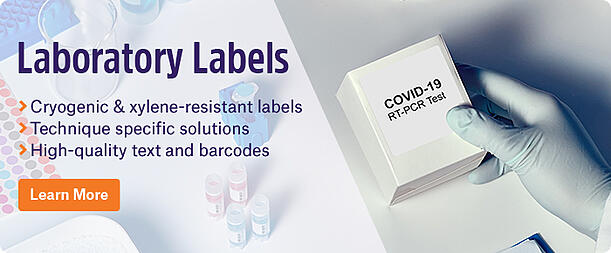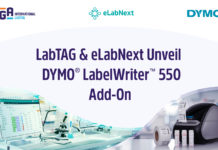
In order to address efficiency gaps in the lab, innovation is necessary to increase productivity while minimizing errors. There are four different kinds of innovation: disruptive, radical, sustaining, and incremental. Disruptive and radical are similar in that they both require upending an existing market; whereas disruptive innovation significantly advances the existing market, radical serves to create an entirely new one. Sustaining innovation can be placed on the other side of the coin, where a company needs to keep up with others’ new disruptive and/or radical innovations. The last kind of innovation is incremental, which likely has the most relevance for laboratories. Incremental innovation entails integrating minor improvements to streamline workflows, optimize processes, and reduce waste.
Labels as a driver of incremental innovation
Sample identification remains an issue among labs, especially medical labs, which patients depend on to ensure the accuracy of analytical test results for biopsies and other specimens. One mislabeled specimen and that patient risks obtaining an inaccurate result, which can impact the care they receive. Labs also have to contend with a variety of environments, such as exposure to harsh chemicals and cryogenic storage, all of which must be considered in order to keep samples consistently identified.
Lab labels can be considered a significant driver of incremental innovation in the lab. Many labs, particularly those in academic settings, still rely on handwriting on tubes and vials, a highly inefficient sample identification method. This is especially glaring when you consider that most processes can be readily digitized. Laboratory information management systems (LIMS) have stepped in within the last few years to help scientists manage and safeguard data via cloud-based systems. In conjunction with LIMS, it is essential that all samples throughout the lab, from experimental specimens to chemical inventories, are identified using either barcodes or RFID labels. By doing so, each sample is linked directly to a database, where tracking and analysis can be performed quickly and accurately.
Because of the different stringent lab environments, labels have become more specialized as well. The most commonly encountered lab environments that can hinder label performance include:
- Cryogenic storage: Storage in liquid nitrogen Dewars and extreme low-temperature freezers requires cryogenic labels. Our Specialized CryoSTUCK® cryo labels have been designed for already frozen containers and can be labeled at -80°C (-112°F), ensuring that samples are not thawed when attempting to over-label or re-label them.
- Chemical exposure: Several common lab applications, like tissue preservation and histochemical analysis, require direct contact with strong organic solvents, such as xylene, toluene, acetone, and formaldehyde. To this end, xylene- and chemical-resistant labels have been designed to resist both exposure and immersion in these chemicals, preventing labels from falling off even during prolonged immersion.
- High-heat sterilization: Sterilization techniques like steam autoclaving, which are used nearly everywhere, from research labs to hospitals and dentist offices, utilize high heat and pressure to sterilize equipment and material. Autoclave labels have been designed to resist elevated temperatures as high as 150°C (302°F) and pressure up to 17 psi.
How to integrate new identification into existing workflows
Adapting any new technology to an already productive environment requires some amount of disruption. If the system already utilizes barcode and/or RFID labels, integration with any new type of label will ultimately be minimal; labels should always be tested prior to wholesale use, but for one or two new types of labels, this can be accomplished relatively quickly and easily by reproducing similar conditions to what they will be used for.
For larger systems that involve the implementation of a new LIMS, barcodes/RFID, and/or scanners, more effort will be required for efficient integration. To help, it is always wise to partner with the identification solution supplier, as they will be able to guide the design, setup, and troubleshooting from the start. Once the system is designed and tested, a training program will be required for all personnel who use the system. This program should be tailored to those who use the system, with follow-up activities to monitor productivity and ensure errors are kept to a minimum, especially during personnel and/or workflow transitions.
LabTAG by GA International is a leading manufacturer of high-performance specialty labels and a supplier of identification solutions used in research and medical labs as well as healthcare institutions.




